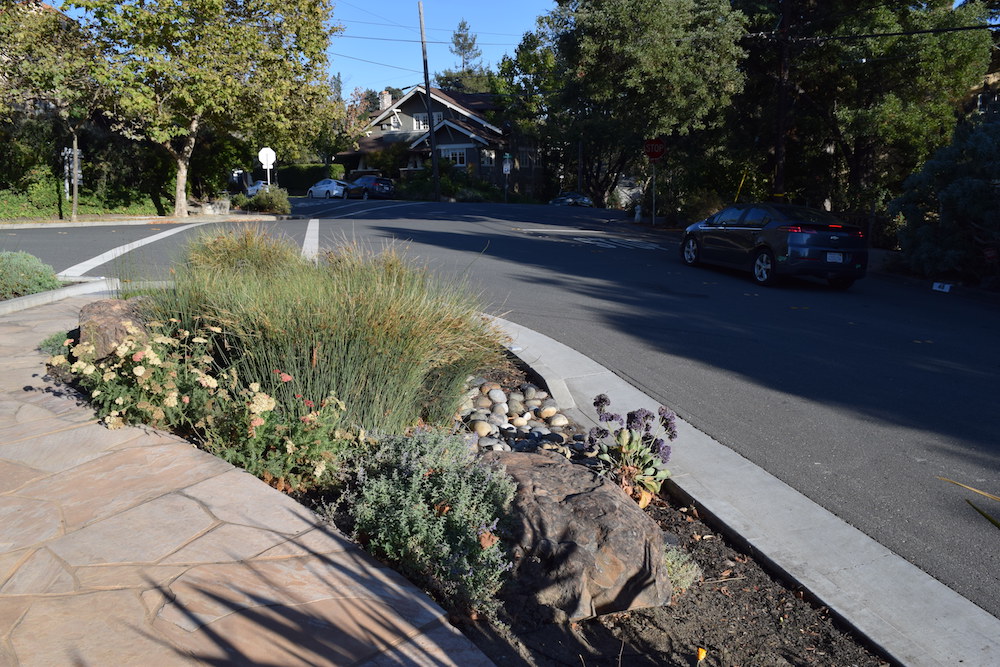The Piedmont Park Commission Wednesday night voted to recommend the City Council adopt a proposed “Green Infrastructure Plan” to guide the city in environmentally friendly construction, particularly projects that make for cleaner storm runoff water.
That 6-0 vote came after commissioners and audience members were assured by Piedmont’s mayor and city staffers that the relatively short list of eight proposed GI projects mentioned in the document is neither set in stone nor reflects the scope of the city’s long-term plans.
The Green Infrastructure Plan’s primary function is to ultimately send cleaner storm runoff water to Lake Merritt and, ultimately, to San Francisco Bay. Much of that involves channeling storm runoff that otherwise would flow across impermeable surfaces, like asphalt and concrete, directly into storm drains. The runoff would instead flow through “bioswales,” landscaping that promotes native plants with minimal demands for water and fertilizers and helps collect and purify water runoff from streets.
There were questions to city staff about that short project list. “You could have been more ambitious about what you chose to put in there,” Park Commissioner Betsy Goodman said.
Added former Planning Commissioner Michael Henn, “Above all, it’s just too timid.”
The proposed projects, at this point, are “placeholders” needed for the plan to qualify for submittal to the San Francisco Bay Regional Quality Control Board and the Alameda County Clean Water Program. They also are projects city planners deem worthy of pursuing — at this point.
“No city can commit to projects over 10 or 20 years with any amount of certainty,” Mayor Robert McBain told the commissioners Wednesday. “Priorities will shift with time and funding.”
City Administrator Sara Lillevand what is billed as a “plan” is probably better described as a “document.”
“The city’s plan around green infrastructure are much bigger than this,” she said. And McBain said, “Green infrastructure is absolutely essential to all these things we’re going to do.”
Piedmont Parks and Project Manager Nancy Kent said many of this plan’s tenets are already included within the city’s general plan, thus ensuring green principles will inform future Piedmont development and maintenance.
The Green Infrastructure Plan took a sort of reverse route to the Park Commission. It had come to the City Council first, on Sept. 16. But council members didn’t vote on it, instead saying the Park Commission — and the public — should have a chance to review and comment on it first. Two members of the public spoke on it Wednesday, and several others had submitted emailed comments to the city.
Piedmont so far has three of the plant-intensive bioswale areas — in Dracena Park, at the intersection of Kingston and Linda Avenues, and at the intersection of Ronada and Ramona Avenues. A fourth one, the first as proposed in the draft Green Infrastructure Plan, would be at the “Lower Grand Triangle” at Grand Avenue at Holly Place.
Piedmont and other Bay Area cities are required by the Municipal Regional Stormwater Permit, adopted by the San Francisco Bay Regional Quality Control Board in November 2015, to develop their own Green Infrastructure Frameworks. Each city’s plan must adhere to Municipal Regional Stormwater Permit requirements.
The plan now comes back to the City Council, which will decide whether or not to accept the Park Commission’s recommendation.
Reach Sam Richards at sam.richards4344@gmail.com

Where Fairview Avenue ends at Grand Avenue is a perfect example of an intersection that can combine traffic mitigation, an attractive bioswale at the bottom of the hill and an excellent location for an attractive gateway into Piedmont with the use of a well planned bulb-out. The City’s current plan only addresses traffic mitigation by the use of additional street striping and unattractive bollards.
The city may have “bigger” plans for GI but it’s vision is pretty narrow. In describing the city’s GI”vision” for streets, Nancy Kent stated only traffic triangles and median strips were being considered – no mention of crosswalks and curbs. Excluding crosswalks and curbs from the GI plan eliminates the major urban planning element being used by other cities to treat street runoff. The photo to this story is a perfect example – a sidewalk bulb out that is filled in with a bioswale. Instead intersections around town are getting paint and bollards. Hopefully Council will consider chairwoman Goodman’s comments and make the GI plan more ambitious by adding pedestrian/bike projects to the plan. And Council should reauthorize CIP funding for the lower Grand and Calvert Court traffic triangles, needless pedestrian improvements, to the Fairview, Greenbank and El Cerrito Ave proposals that are needed pedestrian improvements and now confronting bollards for years to come.